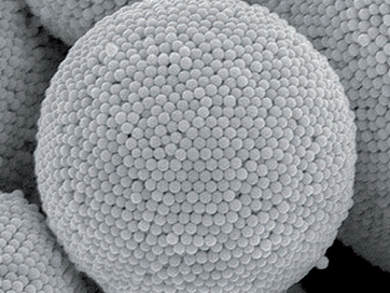Colloidal “Black Gold”
If colloidal gold self-assembles into the form of larger vesicles, a three-dimensional state can be achieved that is called “black gold” because it absorbs almost the entire spectrum of visible light. How this novel intense plasmonic state can be established and what its characteristics and potential medical applications are is explored by Chinese scientists and reported in the journal Angewandte Chemie.
Metal nanostructures can self-assemble into superstructures that offer intriguing new spectroscopic and mechanical properties. Plasmonic coupling plays a particular role in this context. For example, it has been found that plasmonic metal nanoparticles help to scatter the incoming light across the surface of the Si substrate at resonance wavelengths, therefore enhancing the light absorbing potential and thus the effectivity of solar cells.
Plasmonic Vesicles with Strong Absorption and Regular Superstructure
On the other hand, plasmonic vesicles are the promising theranostic platform for biomedical applications, a notion which inspired Yue Li and Cuncheng Li of the Chinese Academy of Science, Hefei, China, and the University of Jinan, China, as well as collaborators to prepare plasmonic colloidosomes composed of gold nanospheres. As the method of choice, the scientists have designed an emulsion-templating approach based on monodispersed gold nanospheres as building blocks, which arranged themselves into large spherical vesicles in a reverse emulsion system.
The resulting plasmonic vesicles were of micrometer-size and had a shell composed of hexagonally close-packed colloidal nanosphere particles in bilayer or, for the very large superspheres, multilayer arrangement, which provided the enhanced stability. “A key advantage of this system is that such self-assembly can avoid the introduction of complex stabilization processes to lock the nanoparticles together”, the authors explain. The hollow spheres exhibited an intense plasmonic resonance in their three-dimensionally packed structure and had a dark black appearance compared to the brick red color of the original gold nanoparticles. The “black gold” was thus characterized by a strong broadband absorption in the visible light and a very regular vesicle superstructure.
Possible Applications in Nanomedicine
In medicine, gold vesicles are intensively discussed as vehicles for the drug delivery to tumor cells, and, therefore, it could be envisaged to exploit the specific light-matter interaction of such plasmonic vesicle structures for medical use, but many other applications are also feasible, as the authors propose: “The presented strategy will pave a way to achieve noble-metal superstructures for biosensors, drug delivery, photothermal therapy, optical microcavity, and microreaction platforms.” This will prove the flexibility and versatility of the noble-metal nanostructures.
- Black Gold: Plasmonic Colloidosomes with Broadband Absorption Self-Assembled from Monodispersed Gold Nanospheres by Using a Reverse Emulsion System,
Dilong Liu, Fei Zhou, Cuncheng Li, Tao Zhang, Honghua Zhang, Weiping Cai, Yue Li,
Angew. Chem. Int. Ed. 2015.
DOI: 10.1002/anie.201503384



![Synthesis of [c2]Daisy Chains via Mechanochemistry](https://www.chemistryviews.org/wp-content/uploads/2025/04/202504_RotaxanesWithSolidStateMechanochemistry-125x94.png)
